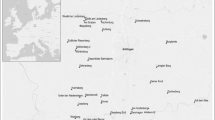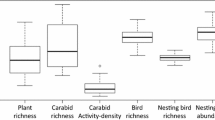Abstract
Agricultural intensification has caused drastic declines in the area and species richness of semi-natural grasslands across Europe. Novel habitats, such as power line clearings, provide alternative habitats and niches for grassland species, and might therefore mitigate these declines. However, it is not fully understood which environmental factors determine the occurrence of grassland species in the clearings. Identifying the most important drivers for grassland species occurrence would help understand the value of the clearings for grassland conservation and target enhanced management into clearings with most potential as grassland habitat. We studied the effects of local environmental conditions, and past and present connectivity to semi-natural grasslands, on the species richness of grassland plants and butterflies in 43 power line clearings in Finland. The results of generalized linear models and hierarchical partitioning showed that increasing time since clear-cut and amount of clearing residue decreased the species richness of both species groups, while the cover of mesic habitats increased it. However, the two species groups showed also divergent responses. Present-day local environmental conditions appeared to be the sole driver of grassland butterfly species richness, whereas the richness of grassland plants was related both to current conditions and historical connectivity to grasslands in 1870–1880s. This suggests the presence of an extinction debt in the studied grassland plant communities, emphasizing the need for enhanced management to increase suitable grassland habitat in the clearings. This would diminish the potential future losses of grassland plant species in the clearings and create valuable habitat for grassland butterflies as well.



Similar content being viewed by others
References
Baillie J, Hilton-Taylor C, Stuart SN (eds) (2004) IUCN red list of threatened species: a global species assessment. IUCN—The World Conservation Union, Gland
Bastin L, Thomas CD (1999) The distribution of plant species in urban vegetation fragments. Landsc Ecol 14:493–507
Berg Å, Ahrné K, Öckinger E, Svensson R, Söderström B (2011) Butterfly distribution and abundance is affected by variation in the Swedish forest-farmland landscape. Biol Conserv 144:2819–2831
Berg Å, Ahrné K, Öckinger E, Svensson R, Wissman J (2013) Butterflies in semi-natural pastures and power-line corridors—effects of flower richness, management, and structural vegetation characteristics. Insect Conserv Diver 6:639–657
Berg Å, Bergman KO, Wissman J, Żmihorski M, Öckinger E (2016) Power-line corridors as source habitat for butterflies in forest landscapes. Biol Conserv 201:320–326
Braun-Blanquet J, Fuller GD, Conard HS (1932) Plant sociology; the study of plant communities. McGraw-Hill Book Company Inc., New York, London
Brückmann SV, Krauss J, Steffan-Dewenter I (2010) Butterfly and plant species suffer from reduced connectivity in fragmented landscapes. J Appl Ecol 47:799–809
Clavel J, Julliard R, Devictor V (2011) Worldwide decline of specialist species: toward a global functional homogenization? Front Ecol Environ 9:222–228
Cousins SAO, Auffret AG, Lindgren J, Tränk L (2015) Regional-scale land-cover change during the 20th century and its consequences for biodiversity. AMBIO 44:17–27
Ekroos J, Kuussaari M, Tiainen J, Heliölä J, Seimola T, Helenius J (2013) Correlations in species richness between taxa depend on habitat, scale and landscape context. Ecol Indic 34:528–535
Ekstam U, Forshed N (1992) If grassland management ceases: Vascular plants as indicator species in meadows and pastures. Naturvårdsverket, Värnamo. In Swedish, with an English abstract
Erhardt A (1985) Diurnal Lepidoptera: sensitive indicators of cultivated and abandoned grassland. J Appl Ecol 22:849–861
Eversham BC, Roy DB, Telfer MG (1996) Urban, industrial and other manmade sites as analogues of natural habitats for Carabidae. Ann Zool Fenn 33:149–156
Finnish Environment Institute (2000) Open access CORINE land cover 2000 raster data, resolution 25 × 25 m. License CC BY 4.0. Accessed 5 May 2016
Fleishman E, Noss RF, Noon BR (2006) Utility and limitations of species richness metrics for conservation planning. Ecol Indic 6:543–553
Guisan A, Edwards TC, Hastie T (2002) Generalized linear and generalized additive models in studies of species distributions: setting the scene. Ecol Model 157:89–100
Hämet-Ahti L, Suominen J, Ulvinen T, Uotila P (eds) (1998) Retkeilykasvio (Field Flora of Finland). Finnish Museum of Natural History. Botanical Museum, Helsinki
Hanski I (1999) Metapopulation ecology. Oxford University Press, Oxford
Heikkinen RK, Luoto M, Virkkala R, Rainio K (2004) Effects of habitat cover, landscape structure and spatial variables on the abundance of birds in an agricultural–forest mosaic. J Appl Ecol 41:824–835
Heliölä J, Pöyry J (2008) Identifying valuable grasslands on power line areas using remote sensing data (in Finnish). Finnish Environ 34(2008):1–42
Helm A, Hanski I, Pärtel M (2006) Slow response of plant species richness to habitat loss and fragmentation. Ecol Lett 9:72–77
Holm S (1979) A simple sequentially rejective multiple test procedure. Scand J Stat 6:65–70
Hutchinson GE (1957) Concluding remarks. Cold Spring Harb Symp Quant Biol 22:415–427
Ibbe M, Milberg P, Tunér A, Bergman KO (2011) History matters: impact of historical land use on butterfly diversity in clear-cuts in a boreal landscape. Forest Ecol Manag 261:1885–1891
Jonason D, Ibbe M, Milberg P, Tunér A, Westerberg L, Bergman KO (2014) Vegetation in clear-cuts depends on previous land use: a century-old grassland legacy. Ecol Evol 4:4287–4295
Komonen A, Lensu T, Kotiaho JS (2013) Optimal timing of power line rights-of-ways management for the conservation of butterflies. Insect Conserv Diver 6:522–529
Korpela E, Hyvönen T, Lindgren S, Kuussaari M (2013) Can pollination services, species diversity and conservation be simultaneously promoted by sown wildflower strips on farmland? Agric Ecosyst Environ 179:18–24
Korpela E, Hyvönen T, Kuussaari M (2015) Logging in boreal field-forest ecotones promotes flower-visiting insect diversity and modifies insect community composition. Insect Conserv Diver 8:152–162
Krauss J, Bommarco R, Guardiola M, Heikkinen RK, Helm A, Kuussaari M, Lindborg R, Öckinger E, Pärtel M, Pino J et al (2010) Habitat fragmentation causes immediate and time-delayed biodiversity loss at different trophic levels. Ecol Lett 13:597–605
Kullberg J, Albrecht A, Kaila L, Varis V (2002) Checklist of Finnish Lepidoptera—Suomen perhosten luettelo. Sahlbergia 6:45–190
Kuussaari M, Ryttäri T, Heikkinen RK, Manninen P, Aitolehti M, Pöyry J, Pykälä J, Ikävalko J (2003) Significance of power line areas for grassland plants and butterflies (in Finnish). Finnish Environ 638:1–65
Kuussaari M, Heliölä J, Pöyry J, Saarinen K (2007a) Contrasting trends of butterfly species preferring semi-natural grasslands, field margins and forest edges in northern Europe. J Insect Conserv 11:351–366
Kuussaari M, Heliölä J, Luoto M, Pöyry J (2007b) Determinants of local species richness of diurnal Lepidoptera in boreal agricultural landscapes. Agric Ecosyst Environ 122:366–376
Kuussaari M, Bommarco R, Heikkinen RK, Helm A, Krauss J, Lindborg R, Öckinger E, Pärtel M, Pino J, Rodà F et al (2009) Extinction debt: a challenge for biodiversity conservation. Trends Ecol Evol 24:564–571
Lampinen J, Ruokolainen K, Huhta AP (2015) Urban power line corridors as novel habitats for grassland and alien plant species in South-Western Finland. PLoS ONE. doi:10.1371/journal.pone.0142236
Levins R (1968) Evolution in changing environments. Princeton University Press, Princeton
Lindborg R, Eriksson O (2004) Historical landscape connectivity affects present plant species diversity. Ecology 85:1840–1845
Lundholm JT, Richardson PJ (2010) Habitat analogues for reconciliation ecology in urban and industrial environments. J Appl Ecol 47:966–975
Luoto M, Rekolainen S, Aakkula J, Pykälä J (2003) Loss of plant species richness and habitat connectivity in grasslands associated with agricultural change in Finland. AMBIO 32:447–452
Mac Nally R (2000) Regression and model-building in conservation biology, biogeography and ecology: the distinction between– and reconciliation of—“predictive” and “explanatory” models. Biodivers Conserv 9:655–671
Mac Nally R (2002) Multiple regression and inference in ecology and conservation biology: further comments on identifying important predictor variables. Biodivers Conserv 11:1397–1401
Milberg P, Bergman KO, Cronvall E, Eriksson ÅI, Glimskär A, Islamovic A, Jonason D, Löfqvist Z, Westerberg L (2016) Flower abundance and vegetation height as predictors for nectar-feeding insect occurrence in Swedish semi-natural grasslands. Agric Ecosyst Environ 230:47–54
Moilanen A, Nieminen M (2002) Simple connectivity measures in spatial ecology. Ecology 83:1131–1145
National Land Survey of Finland (2016) Old printed maps. Basic maps 1:20 000. http://vanhatpainetutkartat.maanmittauslaitos.fi/?lang=en. Accessed 5 May 2016
Öckinger E, Bergman KO, Franzen M, Kadlec T, Krauss J, Kuussaari M, Pöyry J, Smith HG, Steffan-Dewenter I, Bommarco R (2012) The landscape matrix modifies the effect of habitat fragmentation in grassland butterflies. Landsc Ecol 27:121–131
Olea PP, Mateo-Tomás P, de Frutos Á (2010) Estimating and modelling bias of the hierarchical partitioning public-domain software: implications in environmental management and conservation. PLoS ONE. doi:10.1371/journal.pone.0011698
Peel MC, Finlayson BL, McMahon TA (2007) Updated world map of the Köppen-Geiger climate classification. Hydrol Earth Syst Sci Discuss 4:439–473
Pollard E, Yates T (1993) Monitoring butterflies for ecology and conservation. Chapman and Hall, London
Pöyry J, Paukkunen J, Heliölä J, Kuussaari M (2009) Relative contributions of local and regional factors to species richness and total density of butterflies and moths in semi-natural grasslands. Oecologia 160:577–587
Pykälä J (2001) Maintaining biodiversity through traditional animal husbandry (in Finnish). Finnish Environ 495:1–205
Pykälä J (2003) Effects of restoration with cattle grazing on plant species composition and richness of semi-natural grasslands. Biodivers Conserv 12:2211–2226
Pykälä J, Luoto M, Heikkinen RK, Kontula T (2005) Plant species richness and persistence of rare plants in abandoned semi-natural grasslands in northern Europe. Basic Appl Ecol 6:25–33
QGIS Development Team (2014) QGIS geographic information system. Open source geospatial foundation project. http://www.qgis.org
R Core Team (2014) R: a language and environment for statistical computing. R Foundation for Statistical Computing, Vienna, Austria. http://www.R-project.org/
Raatikainen KM, Heikkinen RK, Luoto M (2009) Relative importance of habitat area, connectivity, management and local factors for vascular plants: spring ephemerals in boreal semi-natural grasslands. Biodivers Conserv 18:1067–1085
Rassi P, Hyvärinen E, Juslén A, Mannerkoski I (eds) (2010) The 2010 red list of Finnish species. Ympäristöministeriö & Suomen ympäristökeskus, Helsinki
The National Archives Service of Finland (2016) Russian topographic maps. http://digi.narc.fi/digi/?lang=en_US. Accessed 5 May 2016
Vainio M, Kekäläinen H, Alanen A, Pykälä J (2001) Traditional rural biotopes in Finland—final report of the nationwide inventory. Finnish Environ 527:1–163
Viljur ML, Teder T (2016) Butterflies take advantage of contemporary forestry: clear-cuts as temporary grasslands. Forest Ecol Manag 376:118–125
Wojcik VA, Buchmann S (2012) Pollinator conservation and management on electrical transmission and roadside rights-of-way: a review. J Pollinat Ecol 7:16–26
Acknowledgements
This study received financial support from Fingrid Oyj and The Kone Foundation. We thank the funders for making the study possible, J. Ikävalko, A. Levula, J. Suutari and T. von Bonsdorff for their help in study design and data gathering, and K. Ruokolainen for his help and support on the statistical analyses and manuscript writing.
Author information
Authors and Affiliations
Corresponding author
Additional information
Communicated by Andreas Schuldt.
Electronic supplementary material
Below is the link to the electronic supplementary material.
10531_2017_1430_MOESM1_ESM.docx
SI_Table 1 Pearson correlations between the dependent and the explanatory variables used in the study. SI_Table 2 Grassland plants found in the studied power line clearings (n = 43) in southern Finland. SI_Table 3 Butterflies found in the studied power line clearings (n = 43) in southern Finland. SI_Fig 1 Variation in some of the explanatory variables used in the study. Supplementary material 1 (DOCX 77 kb)
Rights and permissions
About this article
Cite this article
Lampinen, J., Heikkinen, R.K., Manninen, P. et al. Importance of local habitat conditions and past and present habitat connectivity for the species richness of grassland plants and butterflies in power line clearings. Biodivers Conserv 27, 217–233 (2018). https://doi.org/10.1007/s10531-017-1430-9
Received:
Revised:
Accepted:
Published:
Issue Date:
DOI: https://doi.org/10.1007/s10531-017-1430-9




